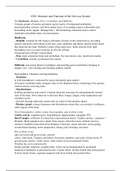CH2: Structure and Function of the Nervous System
The Brainstem: Medulla, Pons, Cerebellum, and Midbrain
Contains groups of sensory and motor nuclei, nuclei of widespread modulatory
neurotransmitter systems, and white matter tracts of ascending sensory information and
descending motor signals. Damage here = life threatening, brainstem nuclei control
respiration and global states of consciousness.
Hindbrain:
- Medulla: essential for life, houses cell bodies of many of the cranial nerves, providing
sensory and motor innervations to the face, neck, abdomen, and throat, and the motor nuclei
that innervate the heart. Medulla is place where path cross, motor neurons from right
hemisphere cross to control muscles on left side of body.
Crossroad most of body’s motor fibers.
- Pons: main connection brain and cerebellum. Eye movements, face, mouth movements.
- Cerebellum: smooth, coordinated movements.
Midbrain: perceiving objects in periphery and orienting gaze toward them, bringing in
sharper view. Also locating and orienting auditory stimuli.
Diencephalon: Thalamus and Hypothalamus
- Thalamus:
in both hemispheres: connected by massa intermedia (gray matter)
all sensory modalities make synaptic relays in the thalamus before continuing to the primary
cortical sensory receiving areas.
- Hypothalamus:
hormone production and control. Controls functions necessary for maintaining the normal
state of the body. Drive behavior to alleviate thirst, hunger, fatigue, body temperature and
circadian cycles.
- does this through endocrine system and via control of the pituitary gland.
- Pituitary gland: releases hormones into bloodstream where they can circulate to influence
other regions of the body.
The Telencephalon: Limbic system, basal ganglia, and cerebral cortex
Limbic system: cingulate gyrus, hypothalamus, hippocampus, amygdala, PFC.
Basal Ganglia: collection of extensively interconnected nuclei. Caudate nucleus + putamen =
Striatum. Basal ganglia receive inputs from sensory and motor areas, striatum receives
extensive feedback projections from thalamus. Functions: action selection, action gating,
reward-based learning, motor preparation, timing, task switching, and more.
The cerebral cortex
sulci (crevices) and gyri (on top, crowns)
cortex: 3mm thick. Contains cell bodies of neurons, dendrites, and some of their axons
grayish (gray matter). Under cortex: white matter axons (myelinated=white)
Dividing the cortex anatomically
frontal, parietal, temporal, occipital lobes. Lobes can be distinguished by prominent
anatomical landmarks as pronounced sulci. Central sulcus: divides frontal lobe from parietal.
Sylvian lateral fissure: separates temporal lobe from frontal and parietal lobes.
, Dividing the cortex cytoarchitectonically
cytoarchitectonic uses microanatomy of cells and their organization to subdivide the cortex.
52 Brodmann areas.
90% cortex is neocortex: cortex that contains six cortical layers or that passed through a
developmental stage involving six cortical layers.
Mesocortex: paralimbic region, includes cingulate gyrus, parahippocampal gyrus, insular
cortex, and orbitofrontal cortex.
Allocortex: 1-4 layers of neurons, includes hippocampal complex.
Functional divisions of cortex
motor areas of the frontal lobe: frontal lobe plays major role in planning and execution of
movements. 2 main subdivisions: PfC and Motor cortex.
Prefrontal cortex: complex aspects of planning, organizing, and executing behavior. ‘center of
executive function’.
Somatosensory areas of parietal lobe: receiving sensory info from outside world, within body
and info from memory + integration of this. (somatosensory cortex= S1 + S2)
Topographical mapping
map or neural representations draped across cortices.
Association cortex: high-end human abilities: language, abstract thinking, designing,
planning.
CH5: Senses, sensation, and perception
Sensation: early perceptual processing
- Shared processing from acquisition to anatomy
1) each system begins with same anatomical structure for collecting, filtering, and amplifying
information from the environment;
2) each system has specialized receptor cells that transduce environmental stimuli into neural
signals.
3) each system has specific sensory nerve pathways. (visual: optic nerve)
- the optic nerve travels from the eye socket to the optic chiasm
- Receptors share responses to stimuli
receptor cells are limited in range of stimuli that they respond to, so their capability to
transmit information has only a certain degree of precision.





